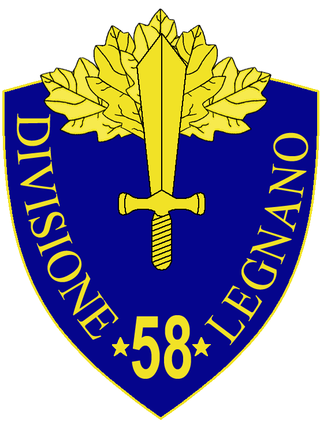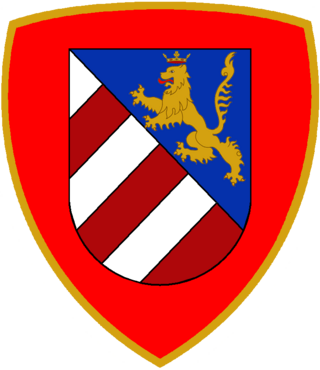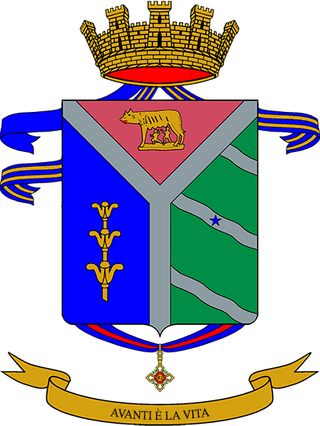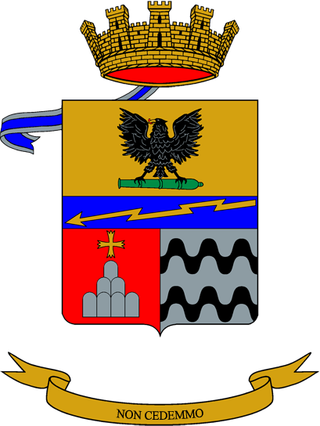
The Italian Co-belligerent Army, or Army of the South, were names applied to various division sets of the now former Royal Italian Army during the period when it fought alongside the Allies during World War II from October 1943 onwards. During the same period, the pro-allied Italian Royal Navy and Italian Royal Air Force were known as the Italian Co-belligerent Navy and Italian Co-belligerent Air Force respectively. From September 1943, pro-Axis Italian forces became the National Republican Army of the newly formed Italian Social Republic.

The Paratroopers Brigade "Folgore" is an airborne brigade of the Italian Army. Its core units are three battalions of paratroopers (paracadutisti). The name "Folgore" is Italian for lightning. The Folgore is one of three light infantry brigades of the Italian Army. While the Folgore specializes in parachute operations its sister brigade in the Division "Vittorio Veneto" the Airmobile Brigade Friuli specializes in helicopter assault operations. The Folgore and its units are based in Tuscany, Veneto and Lazio.
On March 1, 1984 the Italian Institute for Disarmament, Development and Peace (Istituto di ricerche per il disarmo, lo sviluppo e la pace in Rome published the entire Italian Army order of battle down to company level – this was justified by the radical party as one of its core demands was total disarmament of Europe, even though the data which was published was top secret. The Radical Party dissolved in 1989 and the IRDISP followed suit in 1990. But Radio Radicale has survived, and the OrBat can still be found today on the homepage of the radio.
185th Infantry Division "Folgore" was an airborne division of the Royal Italian Army during World War II. The division was formed in Tarquinia near Rome on 1 September 1941. In July 1942 the division was sent to Libya to fight in the Western Desert Campaign and was destroyed during the Second Battle of El Alamein in early November 1942.
The 184th Infantry Division "Nembo" was an airborne division of the Royal Italian Army during World War II. After the Armistice of Cassibile the division joined the Italian Co-belligerent Army's Italian Liberation Corps and together with the Polish II Corps liberated Ancona in the Battle of Ancona.

The 44th Infantry Division "Cremona" was an infantry division of the Royal Italian Army during World War II. The Cremona was formed on 24 August 1939 by splitting the 20th Infantry Division "Curtatone and Montanara" into the 20th Infantry Division "Friuli" and 44th Infantry Division "Cremona". The division was named for the city of Cremona. The division served as occupation force on Corsica and fought German units after the Armistice of Cassibile was announced on 8 September 1943. The division then served with the Italian Co-belligerent Army and remained active until the 1975 Italian Army reform.

The 58th Infantry Division "Legnano" was an infantry division of the Royal Italian Army during World War II. The Legnano's predecessor division was formed on 8 February 1934 in Milan and named for the medieval Battle of Legnano. On 24 May 1939 the division split to form the 6th Infantry Division "Cuneo" and the 58th Infantry Division "Legnano". After the announcement of the Armistice of Cassibile the Legnano resisted the invading German forces. The division's staff and 67th Infantry Regiment "Legnano" were used to form the first unit of the Italian Co-belligerent Army, which fought on the allied side in the Italian campaign. On 17 February 1944 the division's last units joined other commands and the division was officially dissolved.

The Mechanized Brigade "Gorizia" was a mechanized brigade of the Italian Army. Its core units were mechanized infantry battalions. The brigade's headquarters was in the city of Gorizia and the brigade's units were based in the region of Friuli-Venezia Giulia. The brigade's name was chosen in memory of the World War I Battle of Gorizia. The brigade's sister brigade, the Armored Brigade "Vittorio Veneto", was named to commemorate the World War I Battle of Vittorio Veneto.

The Mechanized Brigade "Legnano" was a mechanized brigade of the Italian Army. Its core units were mechanized infantry battalions. The brigade's headquarters was in the city of Bergamo in Lombardy. The name of the brigade commemorates the Lombard League victory in the Battle of Legnano in 1176 and its coat of arms depicts the Monument to the Warrior of Legnano in the centre of Legnano.

The Mechanized Division "Folgore" was a mechanized division of the Italian Army. Its core units were three mechanized brigades. The brigades headquarters was in the city of Treviso.

The 8th Paratroopers Engineer Regiment "Folgore" is an airborne military engineering regiment of the Italian Army based in Legnago in Veneto. The regiment is assigned to the Paratroopers Brigade "Folgore" and combines the lineage and traditions of the Royal Italian Army's 8th Engineer Regiment and VIII Paratroopers Sappers Battalion, and the Italian Co-Belligerent Army's CLXXXIV Mixed Engineer Battalion.

The 185th Paratroopers Artillery Regiment "Folgore is an artillery regiment of the Italian Army, specializing in airborne operations. Originally an artillery regiment of the Royal Italian Army, the regiment was assigned in World War II to the 185th Infantry Division "Folgore", with which the regiment was deployed to North Africa for the Western Desert campaign, during which division and regiment were destroyed in the Second Battle of El Alamein. Reformed in 1975 the regiment is today based in Bracciano near Rome and assigned to the Paratroopers Brigade "Folgore". The regimental anniversary falls, as for all Italian Army artillery regiments, on June 15, the beginning of the Second Battle of the Piave River in 1918.
The following is a hierarchical outline for the Italian Army at the end of the Cold War. It is intended to convey the connections and relationships between units and formations.

The 185th Paratroopers Reconnaissance Target Acquisition Regiment "Folgore" is an Italian Army special forces unit. The regiment is part of the Italian Army's infantry arm's Paracadutisti speciality and assigned to the Army Special Forces Command.
With the 1975 reforms the Italian Army abolished the regimental level and replaced it with brigades made up of multiple arms. During the reform the army disbanded 48 regimental commands and reduced its force by 87 battalions. A further ten regimental commands were used to raise ten new brigade commands. Ten training centers, which for traditional reasons had carried the names of regiments, were also disbanded. The reduction in units also allowed to mechanize most of the remaining units in Northern Italy and Italy's defense strategy changed from a hold-at-all-costs territorial defense to one of mobile warfare.

The 183rd Paratroopers Regiment "Nembo" is an active unit of the Italian Army based in Pistoia in Tuscany. The regiment is part of the Italian Army's infantry arm's Paracadutisti speciality and assigned to the Paratroopers Brigade "Folgore".

The 182nd Armored Infantry Regiment "Garibaldi" is an inactive unit of the Italian Army last based in Sacile in Friuli-Venezia Giulia. The regiment was part of the Italian Army's infantry arm and was last assigned to the Infantry Division "Folgore".
The 184th Paratroopers Regiment "Nembo" is a unit of the Italian Army based in Livorno in Tuscany. Formed in 1942 and active during World War II the regiment is part of the army's infantry arm's Paracadutisti speciality. On 1 October 2022 the regiment's name, flag, and traditions were assigned to the Command and Tactical Supports Unit "Folgore" of the Paratroopers Brigade "Folgore".

The 184th Artillery Regiment "Nembo" is an inactive field artillery regiment of the Italian Army, which was based in Gradisca d'Isonzo in Friuli-Venezia Giulia. Originally an artillery regiment of the Royal Italian Army, the regiment was assigned in World War II to the 184th Infantry Division "Nembo", which was Italy's second paratroopers divisions. After the announcement of the Armistice of Cassibile the division and regiment joined the Italian Liberation Corps and fought on the allied side in the Italian campaign. In 1944 the regiment joined the Combat Group "Folgore" of the Italian Co-belligerent Army and was assigned to the British XIII Corps. During the Cold War the regiment was assigned to the Infantry Division "Folgore" and from 1976 the Mechanized Division "Folgore". The regiment was disbanded in 1996. The regimental anniversary falls, as for all Italian Army artillery regiments, on June 15, the beginning of the Second Battle of the Piave River in 1918.













